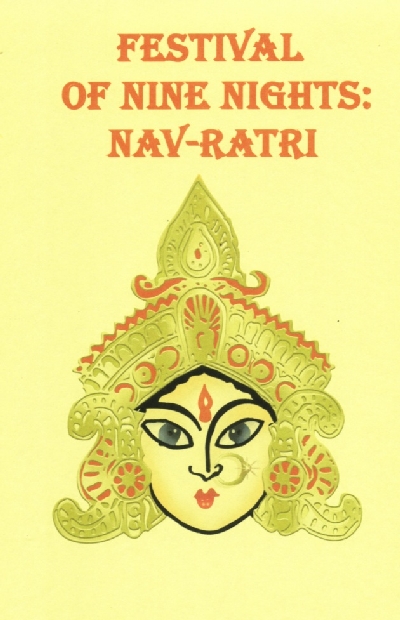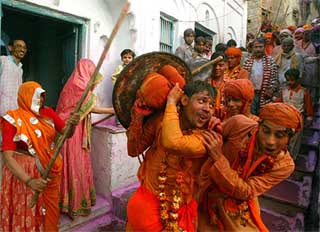









We have all heard of the nine day Navratri festival that takes place in October - November every year. There are however two Navratri's in a year not one. The first Navratri ( which is lesser known and lesser celebrated ) is called Vasant Navratri or Chaitra Navratri. It takes place in the earlier half of the calender year ( usually around March or April) . This Navratri is more celebrated in North Indian states like Himachal Pradesh, Punjab and Haryana. The second Navratri ( in October- November) is celebrated as Durga Puja in Bengal and also as Garba in Gujarat.
This rear in 2008 the Vasant Navratri starts of April 6th 2008, Sri Durga Ashtami is on 12th APril 2008 followed by Ram Navmi. Vasant Navratri also herald the start of the Hindu new Year. This Year it will be the start of the Hindu year 2065.
Legend has it that this first Navratri was the original nine day Navatri during which Sri Durga is worshipped and that Lord Sri Ram changed the period of Durga Puja. Sri Ram invoked the blessings of Goddess Sri Durga before beginning his war with Ravana ( King of Lanka) to gain victory in the Hindu calendar month of Ashwin ( October - November) . This is also why Durga Puja ( celebrated in bengal in October - November is known as "Akal Bodhon" in Bengali which means untimely invocation.
Vasant Navratri is also known as Ram Navratri because Ram Navmi falls on the nine day of Chaitra. This Spring Navratri or Vasant Navratri festival is dedicated to Mother Gauri or Parvati. It marks the change of the seasons and the onset of summer and so its name of Vasant or Basant Navratri.
Almost all the rituals observed during Navratri (held in October-November) are also observed during Vasant Navrati including the nine day fasting.
People also like to have jagran, chooki, in the Navratri time. On the eighth and the ninth day people like to end Navratri by calling small girls to their home and giving them delicious items to eat. This is also called as kanya poojan.
This festival is also known as Navratra ( upnorth) or Kanjakaan ( in Punjab and Haryana). Punjabi's give this celebration the name "Kanjakaan" due to the worship of "Kanjaks" which means little girls who have not yet started their menstrual cycle. The "Kanjaks" are symbolic of Goddess Sri Durga so they are invited home in odd numbers ( 3 or 5 or 7 or 9) on the day of Sri Durag ashtami and are worshiped. First their feet are washed by the women observing the fast of Navratri. Their head and shoulders are then covered with red chunis with gold gota work on it and tilak is put on their foreheads. They are then fed Kala Choley, Puris and Halwa ( Kala Choley is an Indian recipe for Black Chick Peas, Puri is an Indian bread that is deep fried and Halwa is a dessert, see the recipes at www.desifoodtv.blogspot.com). After eating they are sent away with gifts of steel utensils ( usually a plate, glass and katoris). Originally the gifts were probably semi precious metals like gold and silver but with the onset of the modern age steel has replaced these as gifts.
All these rituals are performed by the women who have observed the fast.
I have seen these rituals performed several times in my grandmothers house as a child. In some house this puja also brings in several family traditions, so sometimes these rituals may differ slightly from family to family.
In case of Kanjakaans , persons who fast during these 9 days of Navratri usually eat only one meal a day that too consists of Singhada Atta ( waterchestnut flour) rotis and potatoes in some cases without salt. Some people even drink only milk and go without eating. The idea being that all things that grow with seeds are not to be eaten as Godess Sri Durga also represents the earth mother. No intoxicating drinks or meat or sex is permitted during this time. Some male devotees even do not shave off their beards or cut hair during this period.
Himachal Pradesh hosts every year a huge Chaitra Navratra Fair. Some of the temples that will celebrate Vasant Navratra are Naina Devi,
This festival is also celebrated by other communities such as Bania Aggarwals, Kashmiri pandits and son on in all parts of the country. If you have any knowledge of how this festival is celebrated in your community or home please feel free to add your celebrations or rituals to this blog either as a comment or by writing to me.
The photos are mostly of Godess Sri Durga, kanjaks, devotees having a dip in the Jammu Tawi river during Chaitra Navratri, Ambaji Temple and of kanya puja amongst others.
